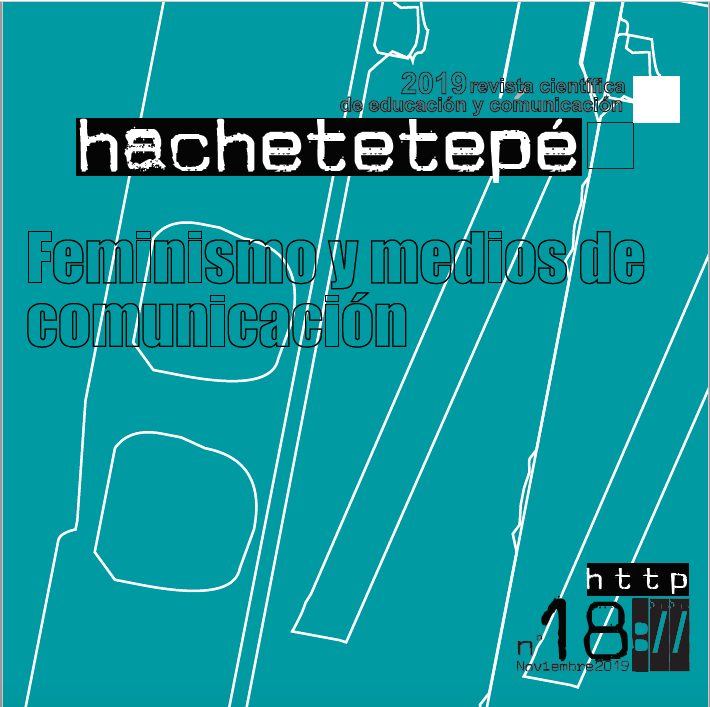Wonder woman: la romantización y sexualidad de un ícono feminista a través del audiovisual

DOI
https://doi.org/10.25267/Hachetetepe.2019.v1.i18.3Información
Resumen
La superheroína Wonder Woman nace como icono feminista en la década de los años cuarenta del siglo pasado. Su difusión, primero a través del cómic y posteriormente del cine, ha sufrido diferentes adaptaciones, algunas con tintes patriarcales. La representación cinematográfica de la princesa amazona como protagonista se caracteriza por la hipersexualización y la romantización del personaje. Este artículo pretende revisar y analizar si el amor romántico y la sexualización son recursos que se repiten en todas sus representaciones y comprender si estos desvían el discurso feminista de esta superheroína.
Descargas
Cómo citar
Licencia

Esta obra está bajo una licencia internacional Creative Commons Atribución-NoComercial-SinDerivadas 4.0.
Aquellos autores/as que tengan publicaciones con esta revista, aceptan los términos siguientes:
- Conservarán sus derechos de autor y garantizarán a la revista el derecho de primera publicación de su obra, el cual estará simultáneamente sujeto a la Licencia de reconocimiento de Creative Commons. Se pueden copiar, usar, difundir, transmitir y exponer públicamente, siempre que se cite la autoría, la url, y la revista, y no se usen para fines comerciales. No se permite hacer obras derivadas.
- Podrán adoptar otros acuerdos de licencia no exclusiva de distribución de la versión de la obra publicada (p. ej.: depositarla en un archivo telemático institucional o publicarla en un volumen monográfico) siempre que se indique la publicación inicial en esta revista.
- Difundir su obra a través de Internet (p. ej.: en archivos telemáticos institucionales o en su página web) una vez que el manuscrito sea aceptado, lo cual puede producir intercambios interesantes y aumentar las citas de la obra publicada. (Véase El efecto del acceso abierto)
Hachetetepé. Revista científica de educación y comunicación no cobra honorarios ni por la presentación de manuscritos ni por la publicación de sus artículos.
Citas
Averett, P. (2009). The Search for Wonder Woman. An Autoethnography of Feminist Identity. Affilia: Journal of Women and Social Work, 24(4), pp. 360- 368.
Beteta Martín, Yolanda (2009). Las heroínas regresan a Ítaca. La construcción de las identidades femeninas a través de la subversión de los mitos. Investigaciones
Feministas. Vol 0, pp. 163-182.
Bourdieu, P. (2000). La dominación masculina. Barcelona: Anagrama.
Butler, J. (2007). El género en disputa. El feminismo y la subversión de la identidad. Barcelona: Paidós.
Butler, J. (2002). Cuerpos que importan. Sobre los límites materiales y discursivos del “sexo”. Barcelona: Paidós.
De Beauvoir, S. (2005). El segundo sexo. Madrid: Cátedra.
Foucault, M. (2006). La historia de la sexualidad 1: la voluntad de saber. Buenos Aires: Siglo XXI.
Galán Fajardo, E. (2007). La imagen social de la mujer en las series de ficción. Cáceres: Universidad de Extremadura.
Guerra López, S. (2006). La violencia de género en la antigüedad. Mito y violencia sexuada en la Metamorfosis de Ovidio (pp. 175-182). Madrid: Instituto de la Mujer.
Herrera Gómez, C. (2016). La creación sociocultural del amor romántico. Madrid: Fundamentos.
Jordana Marín, M. et al (2010). El imaginario de la ambigüedad. Monstruos femeninos en el mundo antiguo. Estrat Critic 5. Vol. 3, pp. 198-205.
Lepore, J. (2015). The secret history of Wonder Woman. Nueva York: Vintage Books.
Lipovetsky, G. (2013). La tercera mujer. Barcelona: Anagrama.
Mainon, D.; James, U. (2008). Amazonas. Guerreras en la pantalla. Madrid: Imágica.
Mayor Ferrándiz, Teresa Mª (2012). Monstruos femeninos en la mitología griega. Revista de Claseshistoria. Art, nº 287, pp. 1-44.
McCausland, E. (2017). Wonder Woman. El feminismo como superpoder. Madrid: Errata Naturae.
Menéndez Menéndez, Mª I. (2006). El zapato de Cenicienta. El cuento de hadas del discurso mediático. Oviedo: Trabe.
Mulvey, L. (1988). Placer visual y cine narrativo. Valencia: Universitat de València.
Lienas, G. (2013). El diario violeta de Carlota. Barcelona: Planeta.
Sanjúan Iglesias, E. Mª (2004). Amazonas en el S. XX: Wonder Woman actualización de un mito. Minius XII, pp. 25-40.
Zurián Hernández, Fr. A.; Herrero Jiménez, B. (2014). Los estudios de género y la teoría fílmica feminista como marco teórico y metodológico para la investigación en cultura audiovisual. Área Abierta, Vol. 14(3).





